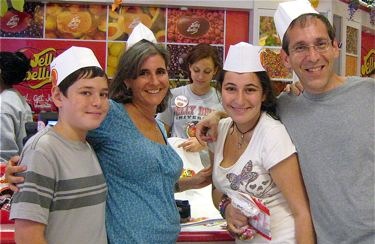 My nearly sixteen-year-old daughter Merav attended the Jerusalem Gay Pride Parade two weeks ago. She had heard about the event, the controversy it had engendered, and thought it would be interesting to see what all the fuss was about.
My nearly sixteen-year-old daughter Merav attended the Jerusalem Gay Pride Parade two weeks ago. She had heard about the event, the controversy it had engendered, and thought it would be interesting to see what all the fuss was about.
It’s funny how time tends to curl around and repeat itself. When I was sixteen, I attended my first gay parade, in the heart of San Francisco’s famed Castro District, for many of the same reasons: curiosity, support, adventure.
The San Francisco parade was a major cultural event for the city. A staggering 250,000 people showed up in 1977; there were floats, flamboyance and not an insignificant amount of PDA (with a goodly sprinkling of near nudity).
Despite San Francisco’s well known reputation for tolerance, the gay community was certainly not immune to controversy: 1978’s Proposition 6 – also known as the Brigg’s Initiative – would have banned gays and lesbians from working in California public schools.
I remember the entire state waiting on pins and needles for the voter outcome (it was defeated in a last minute surprise turn around, dealing former orange juice spokeswoman Anita Bryant’s national anti-gay campaign to its first major defeat).
The euphoria didn’t last long. A short time later came the tragic murder of Harvey Milk, San Francisco’s first openly gay supervisor, played in a virtuoso performance by Sean Penn in the Oscar-winning film “Milk.â€
Those were confusing times for a nerdy young 16-year-old like me who liked to hang out with his straight friends in the heart of the Castro. That boarded up subway station where in the movie Harvey Milk first used his megaphone to charge up an angry mob? There was a performance artist named Ruby Rodriguez who used to do a risqué cabaret act (including rubber chickens and ventriloquism) every Friday night in that same spot. When the bars let out at 2:00 AM, hundreds of drunk, gay men crowded around. My friends and I were there to cheer Ruby on (I have the tape to prove it).
Although I prided myself on my liberal San Francisco values, I got into my own public controversy with the gay community. In 1978, I was writing a column for the local newspaper. In what I thought would be an “eye opening†pro-tolerance piece, I posited that, if 10 percent of the population were gay, then there must be a number of gay men and women in the high school from which I had recently graduated…including, I wrote, “possibly the football team quarterback or the head cheerleader.â€
What was I thinking?
The San Francisco Advocate – a gay-run newspaper – sent a letter of protest to my boss, calling the article homophobic, and I was promptly sacked.
If anything, the pride parade in Jerusalem has stoked even more flames.
True, the Jerusalem version is much tamer than San Francisco’s (or even Tel Aviv’s pride parade earlier in the month which culminated in a group wedding on the beach). But it is no stranger to controversy.
In the past, the parade has been mired by protests by haredi and right wing agitators who consider homosexuality to be a biblical abomination and something that should not be flaunted anywhere, and certainly not in the Holy City. The 2005 parade ended in violence when an ultra-Orthodox man stabbed three participants (he is now serving a 12-year prison sentence).
Then, in 2006, members of the anti-Zionist extremist Eda Haredit religious sect conducted a “pulsa d’nura†– a kabalistic ceremony which, wrote the Jerusalem Post, is believed to “unleash unearthly powers against specific sinners†– to curse the parade.
To the best of my knowledge, lightning did not strike down any revelers that year.
The 2009 version of the parade went off without incident, save for a single case of egg throwing. Haredi protesters steered clear this year, in part to avoid having to explain to their children what the parade was all about. Or perhaps they had bigger fish to fry, like the opening of a parking lot on Shabbat (I’ll save that rant for another post but I just have to ask…where does it say in the Torah that providing a safe and convenient place to park one’s car is a desecration of God’s name?)
In any case, 4,000 people participated in the parade under a police cover of 1,500 officers. Perhaps the biggest complaint was the inevitable traffic jams during the evening rush hour crush.
Still, it got me thinking: what is it about religion that makes one believe that a supernatural being is on the believer’s side or, indeed, that one can reasonably ascertain what that deity’s opinion is on any particular earthly issue?
I’ve still not forgotten, shortly after I first arrived in Israel in 1985, Shas member of Knesset and then Minister of the Interior Yitzhak Peretz placing the blame for a horrendous train accident that killed 22 junior high school students from Petach Tikva on a movie house that was allowed to remain open on Shabbat.
And yet, I fell into that trap myself. In my more religiously extreme days, I tried to take on what I thought was the Orthodox party line regarding homosexuality. My parents were aghast. So was I when I woke up 20 years later and realized how twisted my thinking had become.
Marcia Falk, writing in The Book of Blessings, presents an alternative to the standard Shema prayer:
“Shema Israel, Alfey panim, m’lo olam shekinatah ribuy panecha echad.â€
“Hear O Israel, divinity has thousands of faces, the fullness of the world is its presence, the multiplicity of its faces is One.â€
Falk’s aim in her poetic license, she writes, is “to articulate what a monotheistic belief means to us. To me it means the honoring of diversity within the unity of creation.â€
That diversity means people of all shapes, sizes, shades and, I would add, sexual orientation.
I’m proud that my daughter came out to support the parade, like her father did over 30 years ago. Because I have to believe that, despite what some adherents claim, tolerance is an intrinsic Jewish value and one – borrowing a page of my own from the kabala – that there isn’t enough of in this fractured, broken world.


{ 1 trackback }